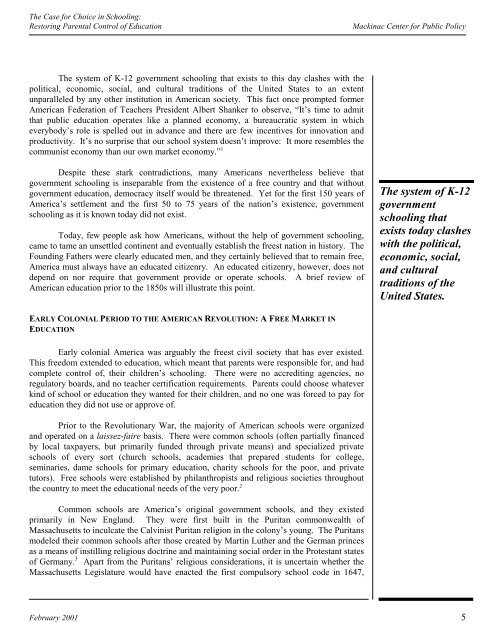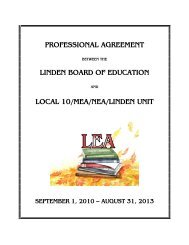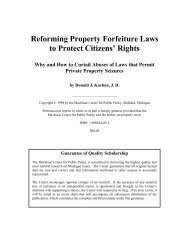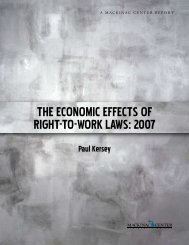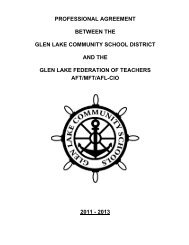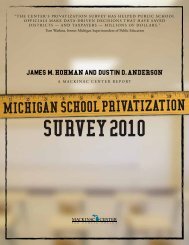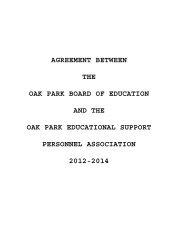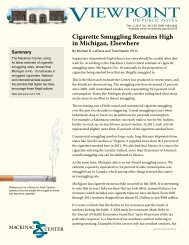The Case for Choice in Schooling - Mackinac Center
The Case for Choice in Schooling - Mackinac Center
The Case for Choice in Schooling - Mackinac Center
- No tags were found...
Create successful ePaper yourself
Turn your PDF publications into a flip-book with our unique Google optimized e-Paper software.
<strong>The</strong> <strong>Case</strong> <strong>for</strong> <strong>Choice</strong> <strong>in</strong> School<strong>in</strong>g:Restor<strong>in</strong>g Parental Control of EducationMack<strong>in</strong>ac <strong>Center</strong> <strong>for</strong> Public Policy<strong>The</strong> system of K-12 government school<strong>in</strong>g that exists to this day clashes with thepolitical, economic, social, and cultural traditions of the United States to an extentunparalleled by any other <strong>in</strong>stitution <strong>in</strong> American society. This fact once prompted <strong>for</strong>merAmerican Federation of Teachers President Albert Shanker to observe, “It’s time to admitthat public education operates like a planned economy, a bureaucratic system <strong>in</strong> whicheverybody’s role is spelled out <strong>in</strong> advance and there are few <strong>in</strong>centives <strong>for</strong> <strong>in</strong>novation andproductivity. It’s no surprise that our school system doesn’t improve: It more resembles thecommunist economy than our own market economy.” 1Despite these stark contradictions, many Americans nevertheless believe thatgovernment school<strong>in</strong>g is <strong>in</strong>separable from the existence of a free country and that withoutgovernment education, democracy itself would be threatened. Yet <strong>for</strong> the first 150 years ofAmerica’s settlement and the first 50 to 75 years of the nation’s existence, governmentschool<strong>in</strong>g as it is known today did not exist.Today, few people ask how Americans, without the help of government school<strong>in</strong>g,came to tame an unsettled cont<strong>in</strong>ent and eventually establish the freest nation <strong>in</strong> history. <strong>The</strong>Found<strong>in</strong>g Fathers were clearly educated men, and they certa<strong>in</strong>ly believed that to rema<strong>in</strong> free,America must always have an educated citizenry. An educated citizenry, however, does notdepend on nor require that government provide or operate schools. A brief review ofAmerican education prior to the 1850s will illustrate this po<strong>in</strong>t.<strong>The</strong> system of K-12governmentschool<strong>in</strong>g thatexists today clasheswith the political,economic, social,and culturaltraditions of theUnited States.EARLY COLONIAL PERIOD TO THE AMERICAN REVOLUTION: A FREE MARKET INEDUCATIONEarly colonial America was arguably the freest civil society that has ever existed.This freedom extended to education, which meant that parents were responsible <strong>for</strong>, and hadcomplete control of, their children’s school<strong>in</strong>g. <strong>The</strong>re were no accredit<strong>in</strong>g agencies, noregulatory boards, and no teacher certification requirements. Parents could choose whateverk<strong>in</strong>d of school or education they wanted <strong>for</strong> their children, and no one was <strong>for</strong>ced to pay <strong>for</strong>education they did not use or approve of.Prior to the Revolutionary War, the majority of American schools were organizedand operated on a laissez-faire basis. <strong>The</strong>re were common schools (often partially f<strong>in</strong>ancedby local taxpayers, but primarily funded through private means) and specialized privateschools of every sort (church schools, academies that prepared students <strong>for</strong> college,sem<strong>in</strong>aries, dame schools <strong>for</strong> primary education, charity schools <strong>for</strong> the poor, and privatetutors). Free schools were established by philanthropists and religious societies throughoutthe country to meet the educational needs of the very poor. 2Common schools are America’s orig<strong>in</strong>al government schools, and they existedprimarily <strong>in</strong> New England. <strong>The</strong>y were first built <strong>in</strong> the Puritan commonwealth ofMassachusetts to <strong>in</strong>culcate the Calv<strong>in</strong>ist Puritan religion <strong>in</strong> the colony’s young. <strong>The</strong> Puritansmodeled their common schools after those created by Mart<strong>in</strong> Luther and the German pr<strong>in</strong>cesas a means of <strong>in</strong>still<strong>in</strong>g religious doctr<strong>in</strong>e and ma<strong>in</strong>ta<strong>in</strong><strong>in</strong>g social order <strong>in</strong> the Protestant statesof Germany. 3 Apart from the Puritans’ religious considerations, it is uncerta<strong>in</strong> whether theMassachusetts Legislature would have enacted the first compulsory school code <strong>in</strong> 1647,February 2001 5


